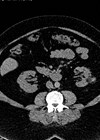Features
Bridging the gap – a nurse-led UTI information and support service
Urinary tract infections (UTIs) are among the most frequently diagnosed bacterial infections in both primary and secondary care. While acute, uncomplicated cases may be managed effectively, recurrent and chronic UTIs often present a more complex challenge. For many people, these...
Artificial intelligence in bladder cancer diagnostics
Bladder cancer (BCa), ranking as the 10th most common cancer worldwide, poses a significant health burden with high morbidity and mortality [1]. Timely tumour detection and accurate evaluation are crucial for effective management, as the prognosis is dependent on the...
Missed Meyer-Weigert duplex ureter during emergency ureteric stenting for ureteric stones
The Meyer-Weigert rule is a fundamental anatomical principle in urology that describes the typical orientation of ureteral orifices in duplex kidneys. In a duplex system, the upper pole ureter usually inserts inferomedially, while the lower pole ureter inserts superolaterally. This...
International urology returns to Scotland
Founded in 1907, the SIU has established itself as the premier international professional society for urologists. As global interdependence increases, so does the relevance of the Society’s mission to enable urologists in all nations to apply the highest standards of...
Can dogs smell prostate cancer?
For centuries we have known that man’s best friend has an exceptional sense of smell. ‘Sniffer’ dogs are found in a wide range of roles, including drug and explosive detection as part of airport security, helping emergency services locate survivors...
Imaging and surveillance in sporadic renal angiomyolipoma: how and when to monitor effectively
Renal angiomyolipoma (AML) are benign tumours, accounting for approximately 2–3% of all renal neoplasms [1]. Seventy percent of renal AMLs are sporadic, and 20–30% are associated with genetic aetiology. They are composed of smooth muscle, blood vessels, and adipose tissue....
Current developments and innovations of the WASHOUT study: A large-scale observational study of inpatient haematuria
Unscheduled haematuria admissions ranks among the most common urological emergencies, yet its investigation and management still lack standardisation. The readmission rate for haematuria is substantial, with reports as high as 8%, and the median hospital stay for such cases in...
Can the latest patient decision aid help OAB patients?
OAB Answers is a patient decision aid co-authored by several European urologists and gynaecologists, and two patient advocates, to help patients understand and manage their overactive bladder (OAB). It is a 36-page document split into several clear sections, aiming to...
How do we tackle social injustice in urological cancer?
Socioeconomic status as an established determinant of health and associated injustices is well recognised. Confronting these injustices and creating a fairer healthcare system is an ongoing challenge for many governments. In Scotland, the devolved government has created the Scottish Index...
Urology around the world: An overview of healthcare in Germany
Germany boasts a highly developed and comprehensive healthcare system, renowned for its quality and accessibility. The urology landscape in the country mirrors this overall excellence, characterised by a well-structured network of specialists, advanced technology, and a strong emphasis on patient-centered...
Urinary retention in women: what a general urologist should know
Urinary retention (UR) is classified by the International Continence Society (ICS) into acute (AUR) and chronic (CUR). AUR is defined as the “inability to pass any urine despite having a full bladder which is painfully distended and readily palpable or...
Using change theories can help nurses implement better care in prostate cancer
Nurses can help support change in prostate cancer care by understanding change management and models and provide leadership in improving prostate cancer care. An important part of being able to lead change is to understand change theories such as the...















